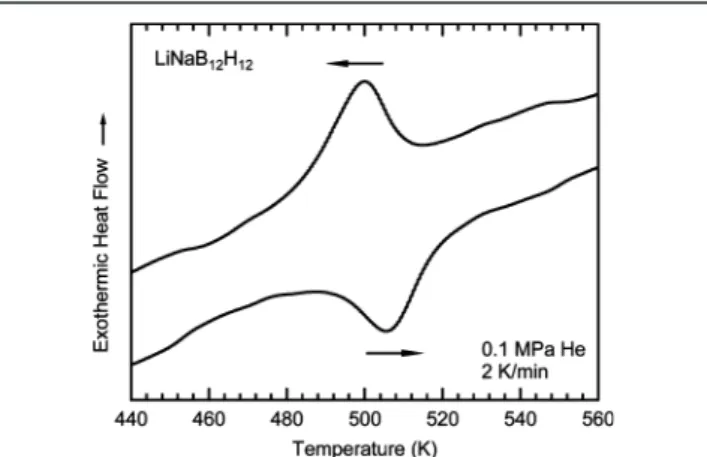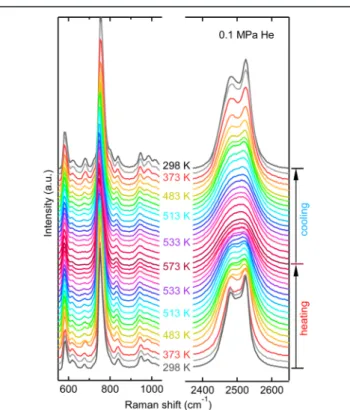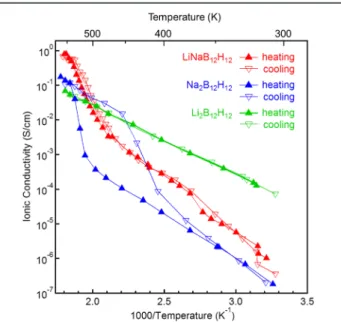RESEARCH OUTPUTS / RÉSULTATS DE RECHERCHE
Author(s) - Auteur(s) :
Publication date - Date de publication :
Permanent link - Permalien :
Rights / License - Licence de droit d’auteur :
Bibliothèque Universitaire Moretus Plantin
Institutional Repository - Research Portal
Dépôt Institutionnel - Portail de la Recherche
researchportal.unamur.be
University of Namur
Synthesis of a Bimetallic Dodecaborate LiNaB12H12 with Outstanding Superionic
Conductivity
He, Liqing; Li, Hai Wen; Nakajima, Hironori; Tumanov, Nikolay; Filinchuk, Yaroslav; Hwang,
Son Jong; Sharma, Manish; Hagemann, Hans; Akiba, Etsuo
Published in: Chemistry of Materials DOI: 10.1021/acs.chemmater.5b01568 Publication date: 2015 Document Version
Publisher's PDF, also known as Version of record Link to publication
Citation for pulished version (HARVARD):
He, L, Li, HW, Nakajima, H, Tumanov, N, Filinchuk, Y, Hwang, SJ, Sharma, M, Hagemann, H & Akiba, E 2015, 'Synthesis of a Bimetallic Dodecaborate LiNaB12H12 with Outstanding Superionic Conductivity', Chemistry of
Materials, vol. 27, no. 16, pp. 5483-5486. https://doi.org/10.1021/acs.chemmater.5b01568
General rights
Copyright and moral rights for the publications made accessible in the public portal are retained by the authors and/or other copyright owners and it is a condition of accessing publications that users recognise and abide by the legal requirements associated with these rights. • Users may download and print one copy of any publication from the public portal for the purpose of private study or research. • You may not further distribute the material or use it for any profit-making activity or commercial gain
• You may freely distribute the URL identifying the publication in the public portal ?
Take down policy
If you believe that this document breaches copyright please contact us providing details, and we will remove access to the work immediately and investigate your claim.
Synthesis of a Bimetallic Dodecaborate LiNaB
12
H
12
with Outstanding
Superionic Conductivity
Liqing He,
†Hai-Wen Li,
*
,‡,§Hironori Nakajima,
†,§Nikolay Tumanov,
⊥Yaroslav Filinchuk,
*
,⊥Son-Jong Hwang,
#Manish Sharma,
∥Hans Hagemann,
∥and Etsuo Akiba
†,‡,§†Department of Mechanical Engineering,‡International Research Center for Hydrogen Energy, and§WPI International Institute for Carbon-Neutral Energy Research (WPI-I2CNER), Kyushu University, Fukuoka 819-0395, Japan
⊥Institute of Condensed Matter and Nanosciences, Université catholique de Louvain, Louvain-la-Neuve 1348, Belgium
#Division of Chemistry and Chemical Engineering, California Institute of Technology, Pasadena, California 91125, United States ∥Département de Chimie Physique, Université de Genève, CH1211 Geneva 4, Switzerland
*
S Supporting InformationM
etal dodecaborates M2/nB12H12(n denotes the valence ofthe metal M), containing icosahedral polyatomic anion [B12H12]2−, have been attracting increasing interest as potential
energy materials, especially in the context of hydrogen storage1,2 and superionic conductivity.3 M2/nB12H12 are
commonly formed as dehydrogenation intermediates from metal borohydrides M(BH4)n, like LiBH4 and Mg(BH4)2,
4−8
which are well-known as potential high-density hydrogen storage materials.9−11The strong B−B bond in the icosahedral [B12H12]2−, however, is regarded to be the key factor that
prevents the rehydrogenation of dodecaborates.12 In order to elucidate the mechanism as well as to provide effective solutions to this problem, a novel solvent-free synthesis route of anhydrous M2/nB12H12 (here M means Li, Na, and K) has
been developed.13Thermal stability and transformations of the anhydrous single phase Li2B12H12 suggested the formation of the high temperature polymorph of Li2B12H12 during the dehydrogenation of LiBH4, while concurrently emphasized the
importance of further investigation on the decomposition mechanism of metal borohydrides and metal dodecaborates.14 The high stability of icosahedral [B12H12]2−, on the other hand, favors its potential application as solid electrolyte. Recently, Na+ conductivity of Na2B12H12 was reported to be 0.1 S/cm
above its order−disorder phase transition at ∼529 K,3
which is comparable to that of a polycrystallineβ″-Al2O3(0.24 S/cm at 573 K) solid state Na-electrolyte.15Mechanistic understanding on the diffusion behavior of cation and further improvement of ionic conductivity at a lower temperature, however, are important in order to facilitate the practical application of metal dodecaborates as superionic conductors.
Bimetallic compounds composed of two different metal elements often show different crystal structures and interesting chemical and physical properties, which are often distinguished from those of the monometallic counterparts. For example, bimetallic borohydrides have been proven as a way to tune the thermodynamics of metal borohydride decomposition.16−18To our best knowledge, there has been no report of improving the ionic conductivity of M2/nB12H12by introducing another metal
to form a bimetallic dodecaborate, and we hypothesized that the coexistence of bimetallic elements could have a synergetic effect on the mobility change of each ion. Here we report for thefirst time that a bimetallic dodecaborate LiNaB12H12could
be a model system in demonstrating the hypothesis, exhibiting lower phase transition temperature (488 K) than its single counterparts of Li2B12H12 (615 K) and Na2B12H12 (529 K),19
and the ionic conductivity of LiNaB12H12 reaches a value of 0.79 S/cm at 550 K. The conductivity value is approximately 8 times higher than that of Na2B12H123and 11 times higher than that of Li2B12H12 at the same temperature.
LiNaB12H12 was prepared through sintering of LiBH4, NaBH4, and B10H14 with a stoichiometric molar ratio of
1:1:1. The successful synthesis was confirmed by X-ray diffraction, Raman spectra, and solid state nuclear magnetic resonance (NMR) measurements (seeSupporting Information
Figure S1). The phase transition of LiNaB12H12, examined by
differential scanning calorimetry (DSC) (Figure 1), occurs at
the temperature of 488 K, which is substantially lower than those reported for pure Li2B12H12(615 K) and Na2B12H12(529
K).19The heats for phase transitions of LiNaB12H12, Li2B12H12, and Na2B12H12 are determined as 9, 22, and 11 kJ/mol,
respectively, based on the DSC measurements (not shown), suggesting that LiNaB12H12 thermodynamically favors the
Received: April 28, 2015
Revised: August 6, 2015
Published: August 7, 2015
Figure 1. Differential scanning calorimetry curves showing the reversible phase transition in LiNaB12H12.
phase transition compared to Li2B12H12 and Na2B12H12. It is worth emphasizing that there is no obvious change of the phase transition in LiNaB12H12 even after 20 cycles of heating and
cooling measurements (seeSupporting InformationFigure S2), whereas a partial decomposition is clearly observed in Li2B12H12
and Na2B12H12.
19
The structural investigations of LiNaB12H12 by synchrotron X-ray powder diffraction were performed in the range 298−613 K (seeSupporting InformationFigures S3 and S4 for Rietveld plots of low- and high-temperature phases). The low temperature structure reveals the cubic Pa3̅ space group symmetry with the cell parameter a = 9.8009(1) Å at 298 K, isostructural to the low-T phase of Li2B12H12.20 The high-T structure shows a cubic F-centered unit cell. The result is different from the behavior of Li2B12H12, for which the high-T
phase was described in the literature as disordered structure in the parent primitive cubic cell.21 We searched further for a better structural model of the high-T phase and found that the high-T phase is better matched with a space group symmetry Fm3̅m where both metal and [B12H12]2− sites are disordered.
The Li/Na mixed-metal site is a stronger scatterer than Li only, which helped us to determine that the unit cell of the high-T phase is clearly F-centered antifluorite structure. We suppose that the high-T phase of LiNaB12H12is isostructural to the
high-T phase of Li2B12H12,21but we and the authors of the past work are using two different models for the description of the same highly disordered structure. Our refinements show a significant positional disorder on the Li/Na site centered at the 8-fold 1/4 1/4 1/4 position; the dodecaborane anions are centered at the 4-fold 0 0 0 position. The anions may be positionally ordered, especially in the F-centered cubic subgroups of Fm3̅m. Interestingly, the antifluorite structure is known to be favorable for superionic conductivity, demonstrated by Na2S.22
The temperature-induced phase transition is reversible, a sequential refinement was done on 313 powder patterns collected, and the cell parameters of the two phases are plotted as a function of T inFigure 2. The unit cell parameters show practically linear T dependences. The phase transition happens at 514 K on heating and at 481 K on cooling, and the cell parameters exhibit nearly the same values (ca. 0.13 Å) of expansion or shrinkage on heating or cooling. Thus, we can state that no hydrogen desorption/absorption occurs at 16.0
MPa H2and temperatures up to 773 K. A similar experiment without hydrogen back pressure shows that hydrogen has no significant effect on the phase transition; the phase transition occurs at 514 K on heating and at 481 K on cooling, and no hydrogen desorption/absorption was observed.
The reversible phase transition is also examined by the in situ Raman spectroscopy measurements as shown in Figure 3.
When the temperature is increased above the phase transition temperature, the B−H bending modes at 618, 680, and 980 cm−1start to disappear at 513 K, the two B−H stretching mode peaks at around 2500 cm−1start to merge, and a single peak is observed at 553 K due to the disordered structure of the high-T phase. When the temperature is decreased below the phase transition temperature (Figure 3), the bending modes at 618, 680, and 980 cm−1reappear, and the stretching band around 2500 cm−1splits into two peaks. DFT calculations on isolated B12H122−and Li2B12H12(with D3dsymmetry, to be as close as possible to the S6local symmetry in the LiNaB12H12 crystal)
were performed to further analyze the origin of these bands. It appears in particular that the band at 680 cm−1, which is not observed in the Raman spectrum of the cubic Cs2B12H12,23 originates from a Raman inactive mode with Ggsymmetry for
the icosahedral B12H122− anion (see the gif animation in the
Supporting Information). The calculated frequencies and experimental Raman frequencies are summarized in the
Supporting Information. It is also important to note that the space groups Fm3̅m and Pa3̅ do not have a direct group− subgroup relation. This fact leads to the hysteresis shown in
Figure 2but is also reflected by the fact that the band at 680 cm−1 disappears suddenly at the phase transition with increasing temperature.
Ionic conductivities of LiNaB12H12 measured by an
electro-chemical impedance spectroscopy (seeSupporting Information, Figure S5) display a significant increase with temperature Figure 2. Unit cell dimension of LiNaB12H12 as a function of
temperature, refined from the in situ synchrotron X-ray diffraction profiles measured at 16.0 MPa H2with a heating rate of 5 K/min.
Figure 3. In situ Raman spectra of LiNaB12H12 upon heating and cooling at 0.1 MPa He.
Chemistry of Materials Communication
DOI: 10.1021/acs.chemmater.5b01568 Chem. Mater. 2015, 27, 5483−5486
(Figure 4): above the phase transition temperature it is 6 orders of magnitude higher than that at room temperature. At 550 K
the ionic conductivity reaches 0.79 S/cm, which is approx-imately 8 and 11 times higher than those for the monometallic systems such as Na2B12H123 and Li2B12H12, respectively. Note
further that below the phase transition temperature of 488 K, the ionic conductivity of LiNaB12H12 is in between those of
Na2B12H12 and of Li2B12H12. Li ionic transport number estimated using polarization responses (see Supporting Information Figure S6) decreases from 0.91 to 0.71 with temperature increased from 393 to 433 K, implying that Li+ contributes much more than Na+ to the superionic
conductivity, but its fraction decreases at elevated temperature. In addition, unlike Na2B12H12 in this work and in the earlier reported studies,3 a much smaller hysteretic behavior is observed for LiNaB12H12 during the cooling process. The significantly improved ionic conductivity and the minimal hysteresis behavior demonstrated by the LiNaB12H12, therefore, prove the synergistic effects of the two metals in the bimetallic dodecaborate. This case further shows the feasibility of designing bimetallic dodecaborates to tune geometric structure and to improve the ion mobility. Further investigation on LiNaB12H12 with different molar ratios of Li/Na, as well as
various bimetallic systems with different ionic radius and valence, is of great importance for the clarification of the detailed mechanism and the improvement of ionic conductivity at moderate temperature for the application of metal dodecaborates as solid electrolyte for batteries.
In conclusion, for the first time we have successfully synthesized the bimetallic dodecaborate, LiNaB12H12, through sintering LiBH4, NaBH4, and B10H14, showing the feasibility of
this process for syntheses of bimetallic dodecaborate series containing no crystal water. The bimetallic series may comprise alkali-earth and transition metals, which are in great need for developing advanced solid state electrolytes and high density hydrogen storage materials. The bimetallic dodecaborate LiNaB12H12 exhibits lower phase transition temperature,
smaller hysteresis, and significantly higher ionic conductivity than its monometallic counterparts, i.e., Li2B12H12 and
Na2B12H12. The revealed Li/Na compositional disorder and the related positional disorder on the metal site are likely responsible for the improved superionic conductivity of LiNaB12H12. These interesting results demonstrate our strategy
of bimetallic dodecaborates to be effective in improving the ionic conductivity.
■
ASSOCIATED CONTENT*
S Supporting InformationThe Supporting Information is available free of charge on the
ACS Publications website at DOI: 10.1021/acs.chemma-ter.5b01568.
Experimental procedures including material synthesis and characterization methods, XRD, Raman and NMR for the material synthesis, 20 cycles of heating and cooling DSC curves, high-resolution X-ray powder diffraction, and electrochemical impedance measurement. Calculated and observed Raman frequencies and correlation table for the Ih group. (PDF)
DFT calculated structure of Li2B12H12 (GIF)
■
AUTHOR INFORMATIONCorresponding Authors
*(H.L.) E-mail:li.haiwen.305@m.kyushu-u.ac.jp. *(Y.F.) E-mail:yaroslav.filinchuk@uclouvain.be.
Author Contributions
The manuscript was written through contributions of all authors. All authors have given approval to thefinal version of the manuscript.
Funding
This work was partly supported by Grants-in-Aid for Scientific Research No. 25709067, JSPS Invitation Fellowship for Research in Japan (Short-Term), the International Institute for Carbon Neutral Energy Research (WPI-I2CNER), spon-sored by the Japanese Ministry of Education, Culture, Sports, Science and Technology of Japan, Fonds Spéciaux de Recherche and FNRS as well as SNBL (ESRF) for the beamtime, and the Swiss National Science Foundation. The NMR facility at Caltech was supported by the National Science Foundation (NSF) under Grant Number 9724240 and partially supported by the MRSEC Program of the NSF under Award Number DMR-520565.
Notes
The authors declare no competingfinancial interest.
■
REFERENCES(1) Li, H.-W.; Yan, Y.; Orimo, S.-i.; Züttel, A.; Jensen, C. M. Recent progress in metal borohydrides for hydrogen storage. Energies 2011, 4, 185−214.
(2) Jena, P. Superhalogens−a bridge between complex metal hydrides and Li-ion batteries. J. Phys. Chem. Lett. 2015, 6, 1119−1125. (3) Udovic, T. J.; Matsuo, M.; Unemoto, A.; Verdal, N.; Stavila, V.; Skripov, A. V.; Rush, J. J.; Takamura, H.; Orimo, S.-i. Sodium superionic conduction in Na2B12H12. Chem. Commun. 2014, 50, 3750− 3752.
(4) Orimo, S.-I.; Nakamori, Y.; Ohba, N.; Miwa, K.; Aoki, M.; Towata, S.-i.; Zuttel, A. Experimental studies on intermediate compound of LiBH4. Appl. Phys. Lett. 2006, 89, 021920.
(5) Li, H.-W.; Kikuchi, K.; Nakamori, Y.; Ohba, N.; Miwa, K.; Towata, S.; Orimo, S. Dehydriding and rehydriding processes of well-crystallized Mg(BH4)2accompanying with formation of intermediate compounds. Acta Mater. 2008, 56, 1342−1347.
Figure 4. Ionic conductivity measurements for LiNaB12H12, Na2B12H12, and Li2B12H12as a function of temperature.
(6) Hwang, S.-J.; Bowman, R. C.; Reiter, J. W.; Rijssenbeek, J.; Soloveichik, G. L.; Zhao, J.-C.; Kabbour, H.; Ahn, C. C. NMR confirmation for formation of [B12H12]2‑complexes during hydrogen desorption from metal borohydrides. J. Phys. Chem. C 2008, 112, 3164−3169.
(7) Friedrichs, O.; Remhof, A.; Hwang, S.-J.; Zuttel, A. Role of Li2B12H12 for the formation and decomposition of LiBH4. Chem. Mater. 2010, 22, 3265−3268.
(8) Ozolins, V.; Majzoub, E.; Wolverton, C. First-principles prediction of thermodynamically reversible hydrogen storage reactions in the Li-Mg-Ca-B-H system. J. Am. Chem. Soc. 2009, 131, 230−237. (9) Züttel, A.; Wenger, P.; Rentsch, S.; Sudan, P.; Mauron, P.; Emmenegger, C. LiBH4 a new hydrogen storage material. J. Power Sources 2003, 118, 1−7.
(10) Filinchuk, Y.; Richter, B.; Jensen, T. R.; Dmitriev, V.; Chernyshov, D.; Hagemann, H. Porous and dense magnesium borohydride frameworks: synthesis, stability, and reversible absorption of guest species. Angew. Chem., Int. Ed. 2011, 50, 11162−11166.
(11) Schouwink, P.; Ley, M. B.; Tissot, A.; Hagemann, H.; Jensen, T. R.; Smrčok, Ĺ.; Černý, R. Structure and properties of complex hydride perovskite materials. Nat. Commun. 2014, 5, 5706.
(12) Li, H.-W.; Akiba, E.; Orimo, S.-i. Comparative study on the reversibility of pure metal borohydrides. J. Alloys Compd. 2013, 580, S292−S295.
(13) He, L.; Li, H.-W.; Hwang, S.-J.; Akiba, E. Facile Solvent-Free Synthesis of anhydrous alkali metal dodecaborate M2B12H12 (M= Li, Na, K). J. Phys. Chem. C 2014, 118, 6084−6089.
(14) Pitt, M. P.; Paskevicius, M.; Brown, D. H.; Sheppard, D. A.; Buckley, C. E. Thermal stability of Li2B12H12 and its role in the decomposition of LiBH4. J. Am. Chem. Soc. 2013, 135, 6930−6941.
(15) Hueso, K. B.; Armand, M.; Rojo, T. High temperature sodium batteries: status, challenges and future trends. Energy Environ. Sci. 2013, 6, 734−749.
(16) Li, H.-W.; Orimo, S.-i.; Nakamori, Y.; Miwa, K.; Ohba, N.; Towata, S.; Züttel, A. Materials designing of metal borohydrides: Viewpoints from thermodynamical stabilities. J. Alloys Compd. 2007, 446, 315−318.
(17) Nickels, E. A.; Jones, M. O.; David, W. I.; Johnson, S. R.; Lowton, R. L.; Sommariva, M.; Edwards, P. P. Tuning the decomposition temperature in complex hydrides: synthesis of a mixed alkali metal borohydride. Angew. Chem., Int. Ed. 2008, 47, 2817−2819.
(18) Ley, M. B.; Ravnsbæk, D. B.; Filinchuk, Y.; Lee, Y.-S.; Janot, R. l.; Cho, Y. W.; Skibsted, J.; Jensen, T. R. LiCe(BH4)3Cl, a new lithium-ion conductor and hydrogen storage material with isolated tetranuclear anionic clusters. Chem. Mater. 2012, 24, 1654−1663.
(19) Verdal, N.; Her, J.-H.; Stavila, V.; Soloninin, A. V.; Babanova, O. A.; Skripov, A. V.; Udovic, T. J.; Rush, J. J. Complex high-temperature phase transitions in Li2B12H12 and Na2B12H12. J. Solid State Chem. 2014, 212, 81−91.
(20) Her, J.-H.; Yousufuddin, M.; Zhou, W.; Jalisatgi, S. S.; Kulleck, J. G.; Zan, J. A.; Hwang, S.-J.; Bowman, R. C.; Udovic, T. J. Crystal structure of Li2B12H12: a possible intermediate species in the decomposition of LiBH4. Inorg. Chem. 2008, 47, 9757−9759.
(21) Paskevicius, M.; Pitt, M. P.; Brown, D. H.; Sheppard, D. A.; Chumphongphan, S.; Buckley, C. E. First-order phase transition in the Li2B12H12system. Phys. Chem. Chem. Phys. 2013, 15, 15825−15828.
(22) Bertheville, B.; Low, D.; Bill, H.; Kubel, F. Ionic conductivity of Na2S single crystals between 295 and 1350 K experimental setup and first results. J. Phys. Chem. Solids 1997, 58, 1569−1577.
(23) Allis, D. G.; Hudson, B. S. Inelastic neutron scattering spectrum of Cs2[B12H12]: reproduction of its solid-state vibrational spectrum by periodic DFT. J. Phys. Chem. A 2006, 110, 3744−3749.
Chemistry of Materials Communication
DOI: 10.1021/acs.chemmater.5b01568 Chem. Mater. 2015, 27, 5483−5486


